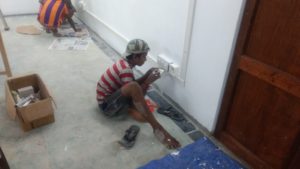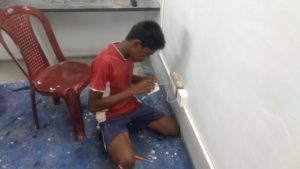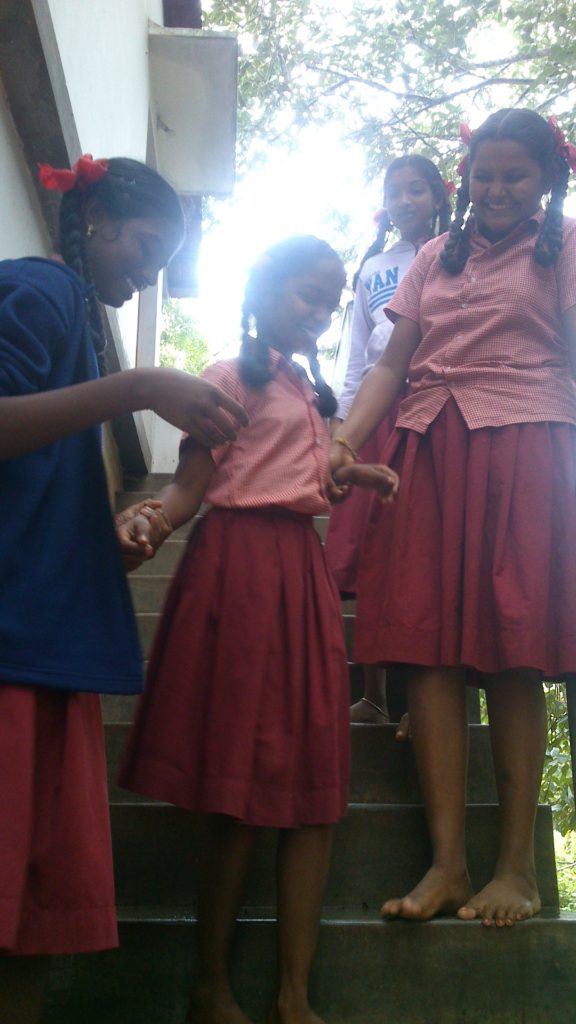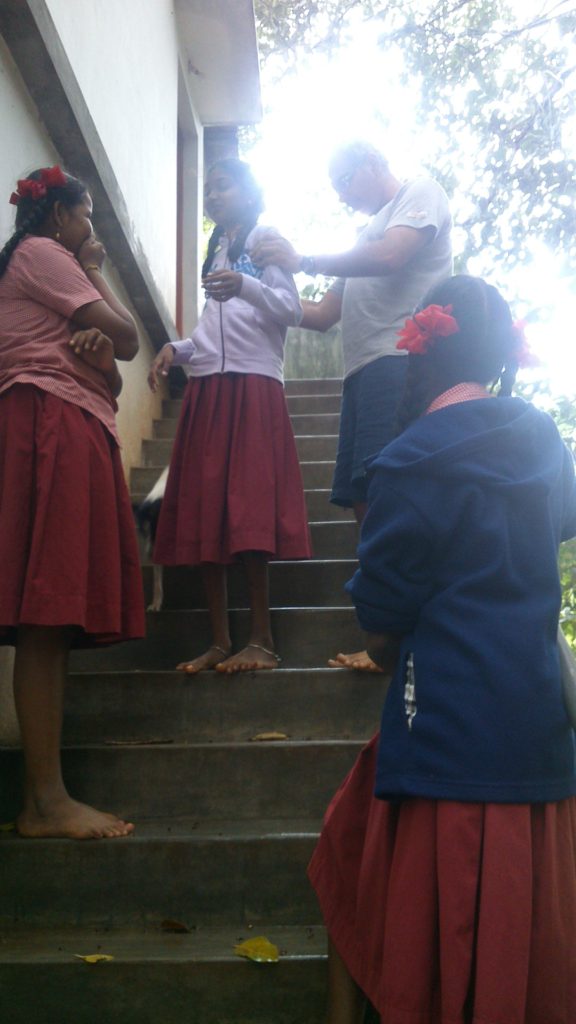During construction:
The lab in iSmart classroom
Work space getting its false ceiling done:
After completion of work:
-Sundar


(formerly Aura Auro Design) – LEARN, GROW, WORK, TEACH
The day before the inauguration of the iSmart class room we had a combined class with two school children the 6th and 7th from Isaiambalam and the 9th graders from Udavi school.
The evening started with a circle and introduction of each others names.
Then the 9th graders from Udavi school had given a list of things they were willing to do that evening from mindstroms to strategy games and scratch programming.
Hema sundar and Kabilan worked with the mindstroms sets and the older lego nxt blocks with the younger children.
Naveen playing bounce off with a Arham.
The tables were arranges so that every couple of minutes the children were asked to switch tables, so as to see all the materials that were being worked on.
It was a combined class with the 7th and 9th graders. I observed that everyone were engaged and were working with their peers and facilitators.
I decided to take a short video of whats happening.
A child from 7th grade made a spinner using MIT app inventor. He took 3 weeks to complete the project.
MIT app Inventor: It is an application where you can make mobile app. It is similar to scratch where you can stick blocks.
The child shares his experience in the video and how he made it.
The 9th grader at Udavi volunteered to paint the new Ismart class room that is being built in the factory side of the Udavi school campus. Which joins along with the Aura Auro Design Lab.
The new space required LAN connectivity.
The LAN cables where already routed to junction boxes which had to be clipped and fixed to the 24 model switch box.
(The box varies from brand to brand, Legrand is easy and takes less time to clip to the individual sockets but is ~ Rs 150 per unit that is 3x larger than other brands) The one that was used required more fine work of screwing and unscrewing individual wires of the CAT 6 LAN cables.


We used straight connection for crimping the rj 45 connectors to the switch box
Then finally we tested if the wires were connected properly with a testing probe.
(The device had eight LED’s that would be connected to both ends of the cables. One of the device was the master and the other was a slave. The master would send a signal for each of the eight wires present on the CAT 6 cable and the slave would light up LED’s accordingly)
We usually have visitors to STEM Land and this week around 20 trainees of the Puchki program(trains teachers to take up environmental aspects) in Auroville had come to STEM Land. They were so excited to see what the children were doing in STEM Land. They were also happy to see how things were organized in STEM and how children learn. They said that, the way children worked here had really inspired them to learn more. Children solved the rubrics cube, demonstrated Lego mindstorm and showed their projects made in Scratch and Geogebra and also explained to them how what they did works. The visitors also put on their logical thinking hats and worked on a few cast puzzles. They saw some children de-soldering the old project kits at the soldering station also asked a few questions to the children about it. The room was filled with lots of energy and eagerness to learn and there I realized the purpose of STEM Land to learn, grow and teach.
During Maths class children were having difficulty in telling tables quickly. Our children were able to tell tables in order but it was difficult when it was random. So we started using Vaughn cube. Vaughn cube is a set of videos which help children to tell tables quickly. We started using the it with 3rd and 4th graders. At first children felt interesting. It middle they felt it was boring because the videos were so long. Then we started to use cards that has been taken from the video. when they started with 3 table they couldn’t tell the number or answer in 3 table. Later when they started noticing the pattern. They when i asked some question they use to tell the object that is present between two number. Once they know all the object they use to jump here and there to tell the answer. They really felt happy that they were tell all the tables from 1 – 10. To tell the tables they need to know 28 objects. Next they need to know between which number certain object should come . Once they knew that they were able to tell tables. If we follow the instruction in the video it will be boring. Vaughn cube should be used in short time and if extended for long time children feels boring. Children wont wait for the teacher to ask the tables. They them self pair together and ask tables in random order.
Link : https://pypi.python.org/pypi/engfmt/1.1.0
engfmt – It is a package used to read and write numbers in engineering format.
In engineering format a number generally includes the units if available and uses SI scale factors to indicate the magnitude of the number.
For example:
1ns
1.4204GHz
This package is designed to convert quantities between the various ways in which they are represented. Those ways are:
As a tuple:
For Eg: “1ns” – would be represented as (1e-9, ‘s’).
As a string in conventional formats:
For Eg: “1ns” – would be represented as ‘1e-9 s’ or as ‘0.000000001s’.
– This form is difficult to read for people.
– engfmt treats it more as a format meant for machines rather than people.
As a string in engineering format:
For Eg: “1ns” – would be represented as ‘1ns’.
– This form is difficult to read for machines
– engfmt treats it more as a human readable format.
The Quantity class is provided for converting between these various forms.
1.It takes one or two arguments.
Eg: Quantity(1e-9) or Quantity(1e-9, ‘s’)
Some examples of the conversions are given below:
For example, any of the following ways can be used to specify 1ns:
As a tuple:
>>> from engfmt import Quantity
>>> period = Quantity(1e-9, ‘s’)
>>> print(period)
1ns
As a string in conventional formats:
>>> period = Quantity(‘0.000000001 s’)
>>> print(period)
1ns
>>> period = Quantity(‘1e-9s’)
>>> print(period)
1ns
As a string in engineering format:
>>> period = Quantity(‘1ns’)
>>> print(period)
1ns
Note: In all cases, the giving the units is optional.
Conversions – Using quantity object you are able to convert it to any representations:
>>> h_line = Quantity(‘1420.405751786 MHz’)
# to converting to tuple with units
>>> h_line.to_tuple()
(1420405751.786, ‘Hz’)
# to converting to string with engineering format
>>> h_line.to_eng()
‘1.4204GHz’
# to converting to string with conventional format
>>> h_line.to_str()
‘1420.405751786e6Hz’
You can also access the value without the units:
# convertig to float
>>> h_line.to_float()
1420405751.786
# converting to a string with conventional format – without units
>>> h_line.to_unitless_eng()
‘1.4204G’
# converting to string with engineering format – without units
>>> h_line.to_unitless_str()
‘1420.405751786e6’
# Get the units only
>>> h_line.units
‘Hz’
There are many other functions also in this package, which is available in the link given.
Some of the functions are given below:
For Example:
>>> period = Quantity(‘1us’)
>> print(period)
1us
For Example:
>>> from engfmt import Quantity
>>> h_line = Quantity(‘1420.405751786 MHz’)
>>> str(h_line)
‘1.4204GHz’
>>> float(h_line)
1420405751.786
For Example:
Plank’s constant:
>>> plank = Quantity(‘h’)
>>> print(plank)
662.61e-36J-s
The best thing in this is it also gives Exceptions:
Eg: A ValueError is raised if engfmt cannot convert a string it into a number:
For Example: >>> try: ... value, units = quant_to_tuple('xxx') ... except ValueError as err: ... print(err) xxx: not a valid number.
Installation / Usage :
Requires Python2.7 or Python3.3 or better.
1. Use ‘pip install engfmt’ in the cmd prompt to install.
2. By importing the .py file:
Children from 8th were learning algebra and had difficulties with the sign operations. They were able to come up with stories of multiplying minus into plus, plus into minus and plus into plus but they couldn’t come up with a story of minus into minus. They asked the volunteers and facilitators to tell a story for it but they couldn’t get the right story for it. Sanjeev gave a story and explained how negative value multiplied with negative value becomes positive. Children even tried the story on the staircase. They closed their eyes and walked backward (negative) and facing down the staircase (negative) and when they opened their eyes they saw themselves climbed few steps up(Positive). They were excited and were able to implement it on their algebraic equations. They had fun while learning it. 

Goanimate story:
Scratch program that randomly takes two numbers and does the same story.
link to scratch code: https://scratch.mit.edu/projects/296602417/
1. Open the terminal (Ctrl + Alt + T).
2. Install imagemagick by
sudo apt-get install imagemagick
2. Go to the directory of the folder in which you want to reduce the image size.
3. Then type the following command
mogrify -resize 800x *
Example :
dell@Inspiron:~/Desktop/Image/$ mogrify -resize 800x *